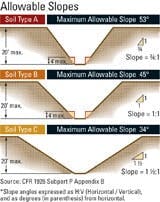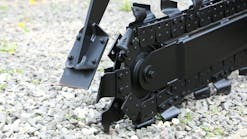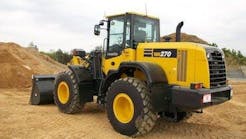The key to safe excavations between 5 and 20 feet deep is that the work be supervised closely by a trained, competent person. (Trenches 20 feet or deeper require a safety system devised by a registered professional engineer.) Competent-person training is available from NUCA, unions and commercial safety-training firms. It should not be intimidating. Anyone who can read equipment manufacturers' tables cross referencing shield and shore models with their soil-type, excavation-depth and width capabilities can pick the right trench box or shores to use in the job at hand. The rest of the federal excavation safety standard (CFR 1926 Subpart P) is a fairly straightforward prescription for inspecting excavations for safety, evaluating soil conditions, and using trench protection safely.
Soil conditions can change in minutes on a dig — faster than the weather — and it's the competent person's job to evaluate soils with every change and determine if the protection system or slopes being used should change.
The federal excavation safety standard squeezes all soils into four types for the purposes of cave-in protection based on their cohesiveness and unconfined compressive strength — the load per surface area at which a soil will collapse into an excavation under its own weight — measured in tons per square foot (tsf). Typically, cohesiveness is determined by a soil sample's resistance to penetration, either by the tip of the competent person's thumb or a pocket penetrometer (a less-than-$60 tool that all competent persons should carry with them). The federal standard calls the first type "stable rock," and defines it as "natural solid mineral matter that can be excavated with vertical sides and remain intact while exposed." Type A soils are cohesive, with unconfined compressive strengths of 1.5 tsf or greater. Everything from silty clay loam to clay and caliche can be included as Type A soil, but the actual classification depends on their condition.
The standard specifies that no soil can be Type A if it is "fissured." The Occupational Safety & Health Administration (OSHA) applies this criterion to stable rock, too.
"There is no such thing as solid rock," says Greg Strudwick, principal of safety consultancy Greg Strudwick & Assoc. and long-time leader of various safety committees for the National Utility Contractors Association. "Rock can never be an A because you can find cracks or fissures in all of it, although it holds itself up better than a clay.
"You might have Type A soil in some clays for a while," Strudwick adds. "But the minute it dries and cracks, it automatically becomes a B. We recognize Type A, but we don't recommend that anybody operate with that classification because it is going to change."
Soil classification and selecting appropriate cave-in protection — not a difficult task to begin with — are made even easier when you understand that two of the four potential classifications are seldom in play. Most excavations are going to be classified as Type B or C soil. Type B soil is cohesive, with unconfined compressive strength between 1.5 and 0.5 tsf.
"That range goes from 3,000-pound soil to 1,000-pound soil, which is a very wide range of unconfined compressive strength," Strudwick points out.
Type C soils are granular, with an unconfined compressive strength of 0.5 tsf or less, meaning a trench cut through them will collapse under less than a 1,000-pound load. Soil that under better circumstances would be Type B is classified as C if it is submerged or there is water seeping from it, or if soil layers slope into the excavation at 4:1 (horizontal:vertical) or steeper.
There are protection-system choices that will secure a broad array of excavations in Type B and Type C soils. Hydraulic aluminum shores with 2-inch-diameter cylinders can protect trenches in Type B soil 5 to 15 feet deep and up to 12 feet wide. Many steel trench boxes will protect a vast array of trench sizes in Type B and practically sized trenches in Type C soils. And even among lightweight, modular trench boxes, there are 8- by 10-foot models that will protect Type B excavations 25 feet deep and Type C excavations down to 16 feet.
Soil conditions must be analyzed at least daily, and the trench protection system adjusted to accommodate significant changes. The competent person's inspection should start first thing in the morning, before anybody is exposed to a cave-in risk, with a visual inspection. Is it fine-grained cohesive soil or loose, granular stuff? Is there water pooling in yesterday's excavation or on the surface or seeping from the walls? Is there soil spalling from the excavation walls?
"As the excavator operator's making his initial cut in the morning, you should look at the soil he's bringing up," says Strudwick. "Obviously you can see if it's sand, or if it's clumping and sticking to the bucket.
"We really recommend that every excavator operator be trained (as a competent person)," says Strudwick. "You need a second (competent person) out on the jobsite in case the foreman's got to run an errand. And that excavator operator knows better than anyone else on the site what type of soil you're working in. If he moves into an area that's got water in it or that goes soft or whatever,he's the one that will know if the shoring system that you're using is not going to be adequate."
A manual test is necessary to confirm a soil classification. The thumb penetration test or testing with a pocket penetrometer is probably the most objective measure of soil strength. Competent-person training details how thumb penetration works, but the basic idea is that when you press the tip of your thumb into a chunk of freshly excavated soil, if you can indent it with moderate effort about half way up your thumbnail or less you're holding a soil of about 1 tsf — in the middle of the Type B range. Your thumb easily penetrates Type C soils several inches, and the soil can be molded with light finger pressure.
"OSHA considers it an acceptable test, but if you don't practice the thumb penetration test — keep up with it and do the necessary due diligence daily — you'll forget how it feels," says Strudwick. "The thing is, it is necessary every day. I think we're getting that across, it just takes a long time to create the culture."
Soil type determines the angle of the slope, or the configuration of shoring, or the type of trench box capable of protecting the work. Type A soils are safe when sloped at ¾:1 (53 degrees), and Type B soils should be sloped at 1:1 (45 degrees). You can finish sloped trenches in Type A and B soils with a 4-foot vertical-walled trench at the bottom. In Type C material, the maximum slope is1½:1.
Sloping excavation walls probably should be a last resort because it requires moving more dirt than necessary. For example, you move 840 cubic feet of material opening a 7-foot trench 4 feet wide and 30 feet long. Deciding to slope those trench walls in a Type B soil, rather than use a trench box or shoring, increases the amount of dirt you have to move 32 percent to 1,110 cubic feet.
The federal excavation standard specifies that spoil should be placed no closer than 2 feet from the edge of the trench. That dimension is intended to prevent a tripping hazard beside the trench and to reduce the likelihood of spoil being accidentally pushed back into the excavation on to workers below.
"You really want to cast the spoil as far away from the trench as practical to keep from surcharging trench walls or banks," says Strudwick.
Vehicles carrying fill material should approach excavations carefully at right angles, with a spotter or other warning system to alert operators when they are close enough to deliver a load. Equipment should never come closer than necessary.
"You don't want equipment to come in at an angle because the near tire creates a load closer to the trench," says Strudwick. "And you don't want them to shake the bucket to pour just a little stone or sand."
OSHA specifies methods of safe egress, or exit, from trenches. Ladders, stairs or ramps must be used in any trench 4 feet deep or deeper, and workers should reach the surface no more than 25 horizontal feet from where they are working. A ladder, if used with a trench box or shoring, must be protected by the system and extend 3 feet above the top of the protection system. There should be a ramp with guardrails to allow laborers to step safely from the top of a trench box onto the bank if the box wall is more than a foot or two from the surface (the safe distance is to be determined by the competent person on site).
The excavation safety standards (both the federal standard and the state-plan standards) are pretty straightforward on the subject of trench protection. There is more to know than what you see here, though. Any excavating firm that doesn't have a competent person on all sites should get employees trained immediately, and make sure they have authority to stop jobs and/or correct unsafe excavating practices.










